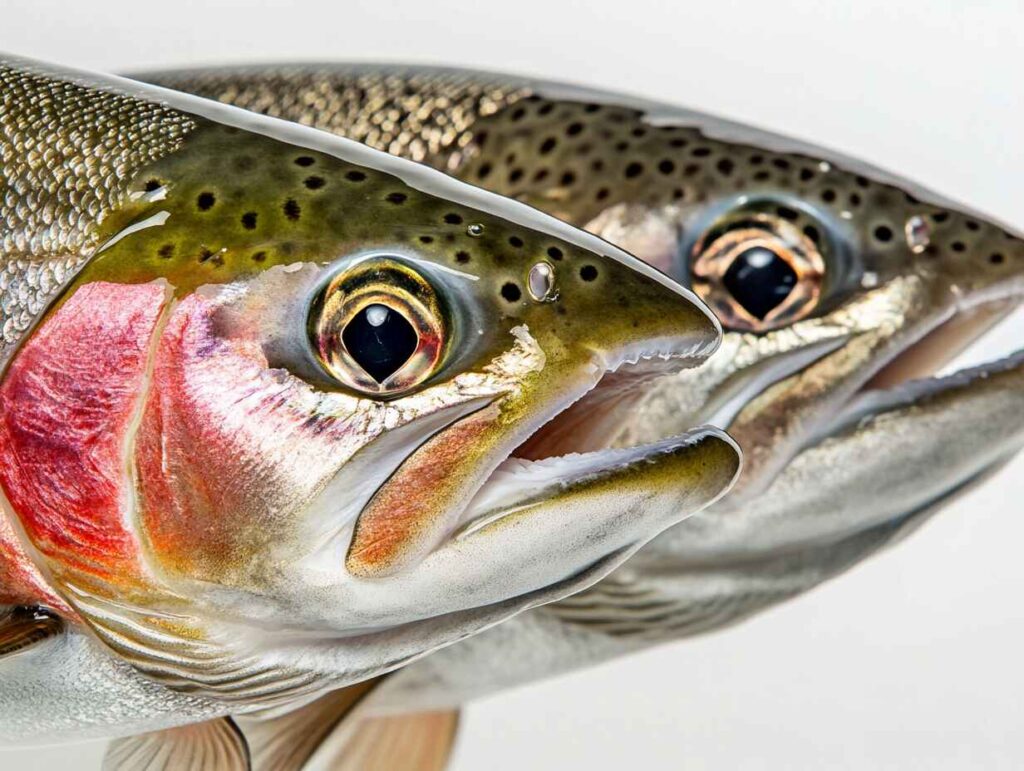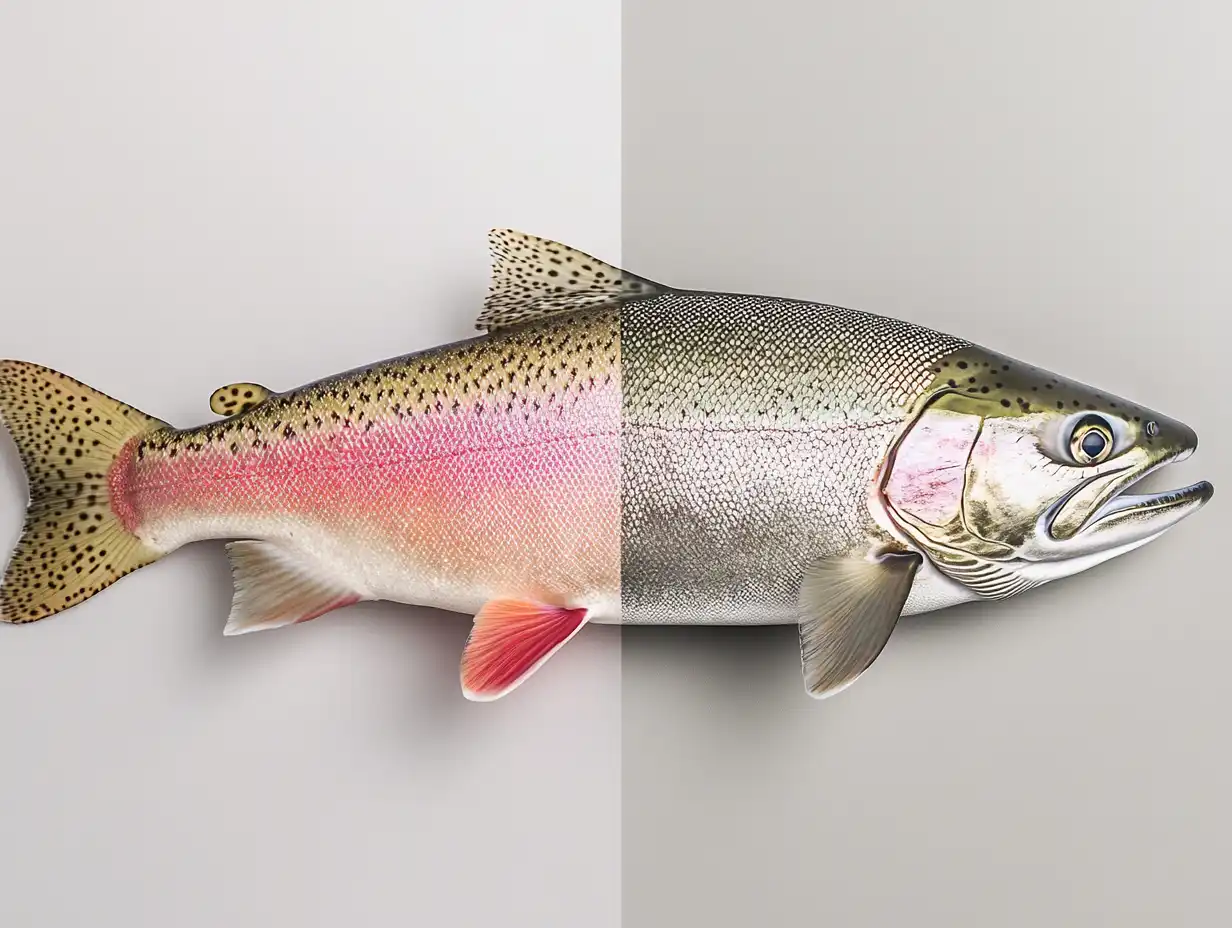whats the difference between a rainbow trout and a steelhead? While these two fish share many traits, their distinct differences, from habitat to life cycle, make them fascinating. Whether you’re an angler, an ecologist, or simply curious, learning about them enriches your understanding of their journeys through rivers and oceans.
Table of Contents
Introduction to Rainbow Trout and Steelhead
Fish enthusiasts might see rainbow trout and steelhead as interchangeable at first glance. They’re both stunning with vibrant hues and spotted patterns, but beyond appearances lies an intricate story of habitat, behavior, and biology.
Understanding the Basics: What Are Rainbow Trout and Steelhead?
Here’s where it all starts: rainbow trout and steelhead are technically the same species Oncorhynchus mykiss. That’s right! Think of them as two sides of the same coin. The primary difference? Steelhead take to the sea while rainbow trout stick to freshwater.
Classification and Taxonomy of Both Species
Both rainbow trout and steelhead belong to the salmon family (Salmonidae). Sharing a lineage with Pacific salmon, they exhibit similar life cycles but diverge when it comes to migration habits.For more about their culinary distinctions, check out Is Steelhead Trout Better for You Than Salmon?.
Shared Ancestry: How They’re Related
These fish originated from cold-water streams in the North Pacific and evolved over millions of years to adapt to their environments. While some stayed close to their freshwater homes (rainbow trout), others developed anadromous tendencies, venturing to saltwater (steelhead).
Physical Differences Between Rainbow Trout and Steelhead
If you’ve ever tried to tell a rainbow trout apart from a steelhead, you know it’s like playing a spot-the-difference game.Let’s break it down:
Size and Weight Comparison
Rainbow trout are generally smaller, averaging 1–5 pounds and about 12–18 inches in length. Steelhead, however, bulk up during their ocean escapades, reaching sizes of 5–20 pounds and up to 40 inches long!
Fun Fact: Steelhead’s ocean lifestyle gives them access to more protein-rich diets, which directly impacts their size and strength.
Coloration and Markings

Rainbows are known for their signature pink stripe running along their bodies, contrasted by an olive-green back and silvery sides. Steelhead, while similar, have a more metallic sheen and darker backs due to their oceanic journeys.
Steelhead also tend to lose some of their vivid rainbow coloring as they mature and migrate. Think of it as a sleek, ocean-inspired makeover!
For tips on preparing trout, visit What is the Best Method of Cooking Trout?.
Habitats and Geographic Distribution
The environments these fish call home play a massive role in their behavior and adaptations.
Freshwater Environments for Rainbow Trout
Rainbow trout thrive in cool, oxygen-rich freshwater rivers, lakes, and streams. You’ll often find them in North America, particularly in the Rocky Mountains, as well as across Europe and Asia, thanks to widespread stocking efforts.
Ocean Migration and Habitats of Steelhead
Steelhead have a more adventurous spirit. Born in freshwater streams, they migrate to the ocean, where they spend up to three years growing and thriving before returning upstream to spawn. The Pacific Northwest, from California to Alaska, is home to many steelhead populations.
Did You Know? Steelhead are anadromous, meaning they migrate between saltwater and freshwater. This trait sets them apart from most trout species.
or a recipe highlighting steelhead’s flavors, try this Steelhead Trout Recipe.
Life Cycle and Reproduction Differences
The life cycles of rainbow trout and steelhead highlight their contrasting lifestyles.
Spawning Behaviors of Rainbow Trout
Rainbows typically spawn in spring, choosing gravelly stream beds with cool, flowing water. Females create nests called “redds,” where they lay their eggs. Once spawning is complete, they continue their lives in the same waters.
Steelhead: Anadromous Lifestyles
Steelhead, on the other hand, embark on epic migrations. After hatching in freshwater, juveniles, known as smolts, make their way to the ocean. After spending years maturing in saltwater, adult steelhead return to their birth streams to spawn. Unlike salmon, steelhead can spawn multiple times, making their lifecycle even more remarkable.
“Steelhead migration is like nature’s version of a triathlon—freshwater, ocean, freshwater—all over again!” 🌊
Curious about whether to eat trout skin? Read Do You Eat the Skin on Steelhead Trout?.
Diet and Feeding Patterns
When it comes to food, rainbow trout and steelhead have their own unique diets tailored to their environments. These feeding habits play a crucial role in their development and, ultimately, their size and health.
Common Prey for Rainbow Trout
Rainbow trout are opportunistic feeders. They eat insects (both aquatic and terrestrial), crustaceans, small fish, and even bits of plant material. Whether it’s a mayfly drifting on the surface or a tiny shrimp hiding in the riverbed, rainbow trout are quick to strike.
Their diet makes them prime candidates for fly fishing, as anglers mimic the look of these insects with their lures. Talk about a crafty predator!
Pro Tip: Early morning and late evening are the best times to catch rainbows, as their prey tends to be most active during these hours. 🌅
Steelhead Diets Across Life Stages
Steelhead, on the other hand, experience shifts in diet as they move between freshwater and the ocean. Juveniles feed on insects and plankton, much like their rainbow trout relatives. However, once they transition to saltwater, their menu expands to include squid, krill, and small fish like herring.
This oceanic buffet fuels their rapid growth, helping steelhead develop the muscular build that makes them a favorite among sport fishers.
Behavior and Survival Strategies
These fish have fascinating behaviors that not only set them apart but also reflect their unique adaptations to different environments.
Territoriality in Rainbow Trout
Rainbow trout are known for their territorial nature, particularly in streams and rivers where food sources can be limited. They’ll stake out prime feeding spots and defend them fiercely. This behavior ensures they get the best pickings of food in their area.
Migration Challenges Faced by Steelhead
Steelhead’s migrations are nothing short of extraordinary, but they’re not without challenges. During their journey from freshwater to the ocean and back again, they face predators, shifting water temperatures, and even man-made obstacles like dams.
Quote: “Every steelhead migration is a test of endurance, resilience, and luck—a true feat of nature.”
Despite these hurdles, steelhead have evolved to adapt, often timing their migrations with optimal environmental conditions to ensure survival.
Importance in Ecosystems and Human Impact
Both rainbow trout and steelhead play vital roles in their ecosystems, acting as both predators and prey. However, human activity has introduced challenges that threaten their populations.
Contributions to Freshwater Ecosystems
Rainbow trout help maintain the balance in freshwater habitats by controlling insect populations. In turn, they’re a key food source for larger predators like bears, birds, and other fish species. Their presence indicates a healthy ecosystem.
Conservation Concerns for Steelhead
Steelhead face a greater risk due to their reliance on both freshwater and marine environments. Climate change, habitat destruction, and overfishing have led to significant population declines. Conservation efforts, such as habitat restoration and sustainable fishing practices, are critical for ensuring their survival.
Emoji Moment: 🌿 Protecting steelhead means safeguarding our rivers, oceans, and everything in between!
Fishing and Culinary Differences
Anglers and food lovers alike have a strong appreciation for both rainbow trout and steelhead, but their differences extend beyond the water. Let’s explore how they compare in fishing techniques and culinary appeal.
Techniques for Catching Rainbow Trout
Rainbow trout are a freshwater favorite for many anglers, partly because they’re widely distributed and relatively easy to catch. Fly fishing is the most popular method, where anglers use lures that mimic insects floating on the water. Other techniques include bait fishing with worms, spinning with lures, or trolling in larger lakes.
What makes rainbow trout such a joy to fish? Their energetic fight when hooked! They leap, dive, and put up an entertaining struggle that keeps anglers coming back for more.
Quick Tip: Look for riffles and pools in streams or areas with structure in lakes when fishing for rainbow trout. These are their favorite hangouts.
Why Steelhead Are Prized in Sport Fishing
Steelhead fishing is a more challenging endeavor, often compared to hunting big game in the fishing world. Because of their size, strength, and migratory behavior, steelhead are revered by anglers as one of the ultimate catches.
Fishing for steelhead often involves drift fishing, where bait or lures are presented naturally along the current, or float fishing, which uses a bobber to drift bait at the right depth. Fly fishing for steelhead, particularly during their spawning runs, is also popular but requires skill and patience.
Steelhead are known for their powerful runs and acrobatics once hooked, making them a thrill to catch. They’re the marathon swimmers of the fish world, and landing one is a badge of honor for any angler.
Common Problems and Solutions: Identifying the Fish
Because rainbow trout and steelhead share so many similarities, distinguishing between the two can be tricky. Let’s tackle some common identification challenges and how to overcome them.
Misidentification Challenges
The overlap in physical traits, like coloration and spotting patterns, often confuses even experienced anglers. Add to that the fact that steelhead return to freshwater with brighter hues, looking much like their rainbow cousins, and the confusion deepens.
Tips for Accurate Identification
Here are a few tips to tell them apart:
- Location Matters: If the fish is caught in freshwater but looks larger and sleeker, it’s likely a steelhead that has returned from the ocean.
- Coloration: Steelhead have a silvery, metallic sheen due to their time in saltwater. Rainbows, meanwhile, retain a more vibrant pink stripe.
- Size: Steelhead are generally larger, though this isn’t foolproof since some rainbow trout can grow large in the right conditions.
Remember: Practice makes perfect. The more time you spend observing these fish, the better you’ll get at telling them apart.
Rainbow Trout vs. Steelhead: FAQs
How can you tell a rainbow trout from a steelhead?
Steelhead are typically larger with a metallic sheen, while rainbow trout are smaller and more vibrantly colored. Their habitats can also be a clue—steelhead migrate to and from the ocean.
Do steelhead and rainbow trout taste different?
Yes! Steelhead, with their saltwater diet, have a richer, firmer flavor, often compared to salmon. Rainbow trout are milder and more delicate.
Are steelhead and rainbow trout the same species?
Yes, both are Oncorhynchus mykiss, but their differing life cycles (steelhead being anadromous) set them apart.
What’s the best bait for catching rainbow trout?
Insects like mayflies, worms, or artificial lures that mimic these prey items work best.
Where are steelhead most commonly found?
Steelhead are native to the Pacific Northwest but can also be found in parts of Canada, Alaska, and even introduced populations in the Great Lakes.
Can rainbow trout and steelhead interbreed?
Yes, they can interbreed since they’re the same species, but such occurrences are rare due to differing habitats and behaviors.
Conclusion: Understanding the Unique Characteristics
Rainbow trout and steelhead are like two siblings with distinctly different lifestyles. While one stays close to home, the other sets off on grand adventures, navigating the challenges of rivers and oceans. Their shared ancestry and striking beauty make them equally fascinating, whether you’re observing them in the wild, casting a line, or enjoying them on your plate.
By learning their differences size, color, habitats, and life cycles you gain a deeper appreciation for these remarkable fish. And the next time someone asks, “What’s the difference between a rainbow trout and a steelhead?” you’ll have all the answers.
For a deeper dive, check out What’s the Difference Between a Rainbow Trout and a Steelhead?.

